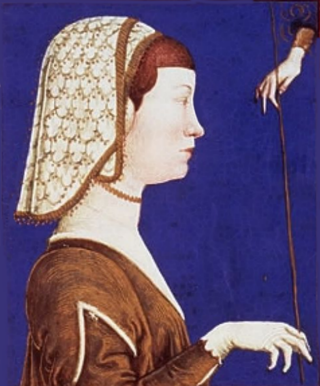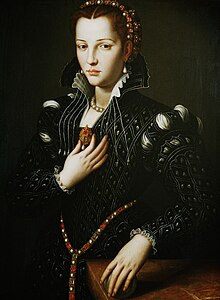Historical background
The poem is preceded by the epigraph "Ferrara:", indicating that the speaker is Alfonso II d'Este, the fifth Duke of Ferrara (1533–1598), who, in 1558 (at the age of 24), had married Lucrezia di Cosimo de' Medici, the 13-year-old daughter of Cosimo I de' Medici, Grand Duke of Tuscany, and Eleonora di Toledo.
Lucrezia was well-educated, and the Medicis could be considered "nouveau riche" in comparison to the venerable and distinguished Este family (Alfonso II d'Este's remark regarding his gift of a "nine-hundred-years-old name" clearly indicates that he considered his bride beneath him socially). She came with a sizeable dowry. He then abandoned her for two years before she died on 21 April 1561, at age 16. Although there was a strong suspicion of poisoning, it is more likely that the cause of her death was tuberculosis. [2] It is speculated that the rumour of poisoning was started by enemies of Alfonso II. [3]
The Duke then, in 1564, sought the hand of Barbara, eighth daughter of the Holy Roman Emperor Ferdinand I and Anna of Bohemia and Hungary and the sister of the Count of Tyrol, Ferdinand II. [4] The count was in charge of arranging the marriage; the chief of his entourage, Nikolaus Madruz, a native of Innsbruck, was his courier. Madruz is presumably the person addressed by the duke in the poem.
The artists named in the poem – painter Frà Pandolf and sculptor Claus of Innsbruck – are fictional.
Synopsis
The speaker (presumably the Duke Alfonso of Ferrara) is giving the emissary of the family of his prospective new wife a tour of the artworks in his home. He draws a curtain to reveal a painting of a woman, explaining that it is a portrait of his late wife; he invites his guest to sit and look at the painting. As they look at the portrait of the late Duchess, the Duke describes her happy, cheerful, appreciative and kind nature, which had displeased him.
He says, "She had a heart – how shall I say? – too soon made glad..." He goes on to say that his complaint of her was that "'twas not her husband's presence only" that made her happy. Eventually, "I gave commands; then all smiles stopped together." In an interview, Browning said, "I meant that the commands were that she should be put to death ... Or he might have had her shut up in a convent." [5] The duke now keeps her painting hidden behind a curtain that only he is allowed to draw back, thus now she only smiles for him.
The Duke demonstrates many narcissistic tendencies as he recalls the time he shared with his now-deceased Duchess. He then resumes an earlier conversation regarding wedding arrangements, and in passing points out another work of art, a bronze statue of Neptune taming a sea-horse by Claus of Innsbruck, so making his late wife just another work of art.
The envoy remains silent throughout the Duke's discourse and revelations.

Lucrezia Borgia was an Italian noblewoman of the House of Borgia who was the illegitimate daughter of Pope Alexander VI and Vannozza dei Cattanei. She reigned as the governor of Spoleto, a position usually held by cardinals, in her own right.

Torquato Tasso was an Italian poet of the 16th century, known for his 1591 poem Gerusalemme liberata, in which he depicts a highly imaginative version of the combats between Christians and Muslims at the end of the First Crusade, during the Siege of Jerusalem of 1099.
"Porphyria's Lover" is a poem by Robert Browning which was first published as "Porphyria" in the January 1836 issue of Monthly Repository. Browning later republished it in Dramatic Lyrics (1842) paired with "Johannes Agricola in Meditation" under the title "Madhouse Cells". The poem did not receive its definitive title until 1863.

Renée of France, was Duchess of Ferrara from 31 October 1534 until 3 October 1559 by marriage to Ercole II d'Este, grandson of Pope Alexander VI. She was the younger surviving child of Louis XII of France and the duchess regnant Anne of Brittany. In her later life, she became an important supporter of the Protestant Reformation and ally of John Calvin.

Alfonso d'Este was Duke of Ferrara during the time of the War of the League of Cambrai.

Claudia de' Medici was Regent of the Austrian County of Tyrol during the minority of her son from 1632 until 1646.
"Andrea del Sarto" is a poem by Robert Browning (1812–1889) published in his 1855 poetry collection, Men and Women. It is a dramatic monologue, a form of poetry for which he is famous, about the Italian painter Andrea del Sarto.

Alfonso II d'Este was Duke of Ferrara from 1559 to 1597. He was a member of the House of Este.

Margherita Barbara Gonzaga, was an Italian noblewoman, Duchess consort of Ferrara, Modena and Reggio between 1579 and 1597 by marriage to Alfonso II d'Este, Duke of Ferrara, Modena and Reggio. She was a significant cultural patron in Ferrara and Modena.

Barbara of Austria, was an Archduchess of Austria as a member of the House of Habsburg and by marriage Duchess consort of Ferrara, Modena and Reggio during 1565–1572.

Joanna of Austria was an Archduchess of Austria. By marriage to Francesco I de' Medici, she was the Grand Princess of Tuscany and later the Grand Duchess of Tuscany. One of her daughters was Marie de' Medici, second wife of King Henry IV of France.

Lucrezia de' Medici was a member of the House of Medici and by marriage Duchess consort of Ferrara, Modena and Reggio from 1558 to 1561.

Eleanor of Naples was Duchess of Ferrara by marriage to Ercole I d'Este. She was the first duchess of Ferrara, and mother of many famous Renaissance figures. She was a well known political figure, and served as regent of Ferrara during the absence of her spouse.

Maria de' Medici was the eldest child of Cosimo I de' Medici, Grand Duke of Tuscany and Eleonora di Toledo. She was a member of the famous Medici family.

Eleonora di Garzia di Toledo or Leonor Álvarez de Toledo Osorio, more often known as "Leonora" or "Dianora", was the daughter of García Álvarez de Toledo, 4th Marquis of Villafranca, Duke of Fernandina. Leonora was born in Florence, where she was brought up by Cosimo I de' Medici, Grand Duke of Tuscany and his wife Eleanor of Toledo, her aunt and namesake. Betrothed to their son Pietro at the age of 15, she blossomed under the wing of Pietro's older sister, the artistic patron Isabella, into a vivacious and witty beauty. Her marriage, like Isabella's, was not a success, and she followed her mentor's example of taking lovers. For this reason, Pietro had her brought in 1576 to the country retreat of Cafaggiolo, where he strangled her to death with a dog leash. Cosimo's successor, Francesco I, tacitly approved the murder, and Pietro was never brought to justice for it.

Isabella Clara of Austria was a Duchess consort of Mantua, Montferrat, Nevers, Mayenne and Rethel by marriage to Charles II, Duke of Mantua and Montferrat.

Anna de' Medici was a daughter of Cosimo II de' Medici, Grand Duke of Tuscany and his wife Maria Maddalena of Austria. A patron of the arts, she married Ferdinand Charles, Archduke of Further Austria in 1646. They were the parents of Claudia Felicitas of Austria, Holy Roman Empress.

Rodrigo of Aragon, Duke of Bisceglie and Sermoneta of the House of Trastámara, was the only child of Lucrezia Borgia, daughter of Pope Alexander VI, and her second husband Alfonso of Aragon, son of Alfonso II of Naples.

Sigismondo d' Este was the youngest son of Ercole I d'Este, Duke of Ferrara, and Eleanor of Aragon, daughter of Ferdinand I of Naples.

Lucrezia d'Este was an Italian noblewoman. By birth she was a member of the House of Este, and by marriage to Francesco Maria II della Rovere, Duke of Urbino she was Duchess consort of Urbino and Sora, and Lady consort of Pesaro, Senigallia, Fossombrone and Gubbio.



















